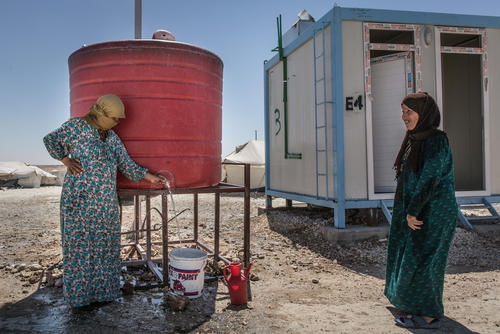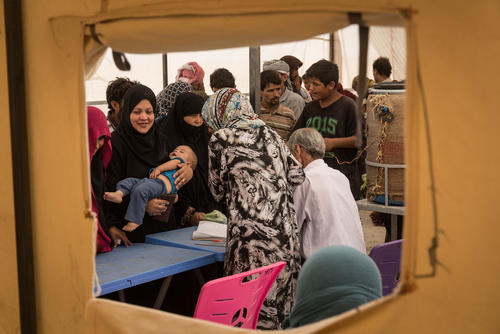Located in the north-east of Syria, Ain Issa camp is at the crossroads between people fleeing violence and areas controlled by the Islamic State (IS) group. Around 8,000 people are currently living in this camp. “There are new arrivals every day”, observes Arnaud Fablet, Emergency Coordinator for Médecins Sans Frontières (MSF). “However the total amount of people living in the camp remains relatively stable, as some are only here in transit.”
Displaced people come from the Deir ez-Zor area, a city controlled by the IS group that the Syrian army is trying to reclaim, and Raqqa, another IS group stronghold. It’s in Raqqa that the Syrian Democratic Forces (SDF) – an alliance of Kurdish and Arab soldiers – launched an attack in June and now surround the city.
While the international coalition supporting the SDF are intensifying airstrikes on Raqqa, only half of the 1,250 people who have arrived at Ain Issa camp between 10 and 24 August were coming from the city. “In May, 90 per cent of the displaced people were coming from Raqqa and its surroundings”, explains Arnaud Fablet. “Then in July and at the beginning of August, they were mostly coming from the Deir ez-Zor area.” While the number of arrivals has increased since mid-August, it remains comparatively few. According to the United Nations, 25,000 civilians might still be trapped in the besieged zone.
“We are worried because we don’t have any information about what’s going on inside Raqqa”, explains Arnaud Fablet. “The main issue for us is the welfare of the wounded. Despite daily airstrikes, we received only one wounded person from Raqqa in our hospital in Kobane/Ain Al Arab in the last three weeks.”

At Ain Issa camp, some people who have fled the fighting are only passing through. Indeed those who come from Deir ez-Zor generally continue on their way to Turkey, where they hope to find shelter. Those who are only transiting through the camp include Iraqi refugees who left Tal Afar, a city held by IS group on the Iraqi side of the border, several weeks ago, and are trying to re-enter Iraq through Turkey.
But whether they are in transit or staying in the camp, everyone must register and pass through a security check when they arrive. Next to the registration point, an MSF team is available onsite to provide first aid care, which consists in screening children for malnutrition, distributing hygiene kits and baby formula when needed, and vaccinating children under five.
Inside the camp, MSF provides water by truck in cooperation with another NGO, and recently drilled a borehole. MSF also runs a dispensary where a team provides medical consultations and refers patients who need to be hospitalised to Kobane or Tal Abyad hospital. Very few people among the patients in Ain Issa suffer from malnutrition. The main problems are diarrhoea, skin diseases and body pains, which are linked to the living conditions inside the camp. The conditions are indeed very harsh: temperatures reach 45°C, and the air is often filled with dense dust. Displaced people living there are waiting for only one thing: the end of the fighting in Raqqa, so they can go home.
After six years of war, population movements in Syria continue in the north of the country, where MSF teams provide medical care, including in Menbij, Tal Abyad, Hazeema and Al-Hasakah. This support is indispensable, as the conflict has profoundly disrupted the Syrian healthcare system. A lot of children would not receive vaccinations. In Ain Issa, MSF is providing routine vaccinations and plans to organise a catch-up vaccination campaign against measles.



